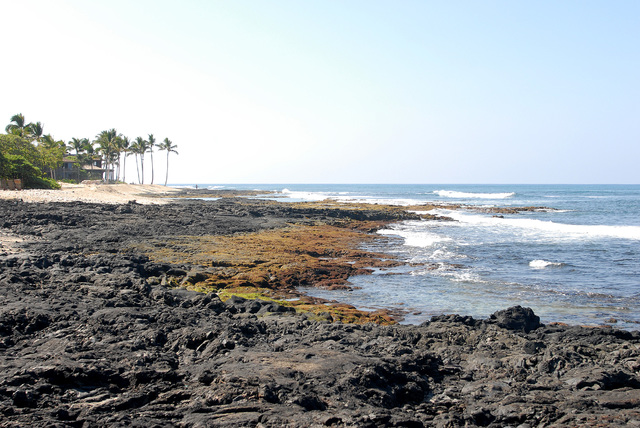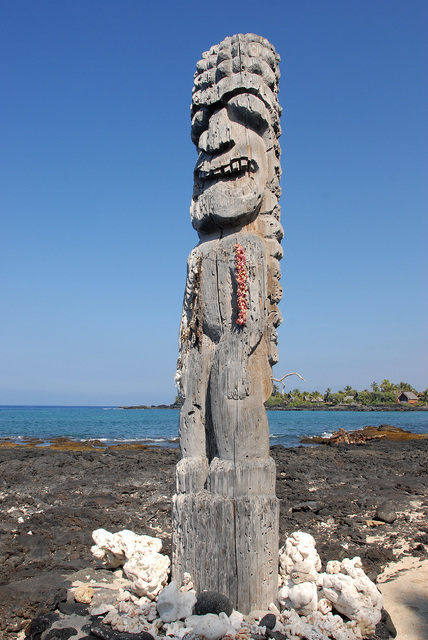KAILUA-KONA — Some rules aren’t just meant to be broken, they need to be broken, or so believes president of the Pele Defense Fund Palikapu Dedman.
KAILUA-KONA — Some rules aren’t just meant to be broken, they need to be broken, or so believes president of the Pele Defense Fund Palikapu Dedman.
Gov. David Ige signed a rule last week establishing a marine reserve at Kaupulehu. The rule carries with it a 10-year, near shore rest period, which essentially amounts to a fishing ban with limited exceptions, out to a depth of 120 feet across a 3.6 mile stretch of the West Hawaii coastline.
The rule, which takes effect Friday and extends through the summer of 2026, was enacted to allow time for reef fish stocks to replenish before a fishery management plan is implemented for the Kaupulehu Marine Reserve, according to the Department of Land and Natural Resources.
Dedman, incensed by the governor’s action Wednesday, announced his intention to fly directly in the face of the rule, thereby creating a situation he said will demand litigation and bring a voice to his organization’s concerns the only way he believes a voice can be attained — through action.
“I am planning on going out there and bringing a whole bunch of Hawaiians to go fishing,” Dedman said. “Being on the up-and-up about it, they don’t want to hear you. So now, you got to be forced to go through this kind of process.”
Dedman petitioned for a general practice exemption to the rule for native Hawaiians, which would have allowed them to continue fishing the area for religious and subsistence purposes.
He agrees with banning commercial fishing in the reserve, but added administrators failed to seriously consider traditional Hawaiian practices. He also asserted the rule violates Hawaiian gathering rights.
“They say they have the right to regulate (my religion), but they don’t regulate other religions,” Dedman said. “This is a 10-year ban. Why don’t you stop Easter for 10 years? Why don’t you tell American Indians they can’t eat salmon? We keep whittling away at Hawaiians until they have no reason to be Hawaiian anymore. This is how it starts. If we allow it to happen on the Big Island, it will spread 149 miles from South Point all the way to Pololu Point.”
Dedman further contended native Hawaiians have in no way contributed to the depletion of aquatic life in the reserve and feels the group is being punished for a problem stemming from over-development and Western contact in general.
“Hawaiians around the world can come home and go fishing — that is our right,” Dedman said. “And if there ain’t no fish, that is not my fault, and they don’t stop me from my practice. You deplete my resources, and now you can kill my practice? Hey, let my practice happen. I will bring lunch.”
But Dedman’s perspective isn’t the only one floating around in contested waters.
According to a DLNR press release, several fisherman and native Hawaiians view the issue from a completely different angle and have been committed to the enactment of this rule for nearly two decades.
“The establishment of this reserve is largely due to the steadfast commitment and efforts of many community members, including longtime fishermen and native Hawaiians who live and fish in this area,” said Suzanne Case, chair of the DLNR. “They worked for more than 17 years to get support for the Kaupulehu Reserve.”
Some of the support garnered may be tied to the fact that the hiatus on fishing is not permanent.
Bruce Anderson, administrator of the Division of Aquatic Resources, said coral reef ecosystems have the ability to rebound in less than a decade if provided with optimal conditions.
The quality of marine life in the area will be monitored annually, and once it has become more robust, certain types of fishing will be permitted under a new, responsible management plan, he said.
But Calvin Lai, owner of Kona Coast Spearfishing, isn’t so sure he or his son will be diving in one of the island’s premier spearfishing locations a decade from now — or ever again — as marine life assessments he’s not sure are accurate will act as qualifiers for future action on the issue.
Lai also voiced concern that the rule may be geared toward appeasing tourism interests, as a considerable portion of the reserve is located around the reef near Four Seasons Resort Hualalai.
“I’m pretty upset about it. There was really no compromise with this ban. I see no depletion of fish over there, really, and it really affects my business,” Lai said. “I believe nobody owns the ocean. Why can’t we share it with the hotel and all those rich people there?”
Captain Jeff Rogers said fishing beyond the 120-foot depth zone will also be affected, as “new reserve boundaries will encompass the existing Kaupulehu Fish Replenishment Area,” according to the DLNR release.
Rogers said the FRA’s ocean-side boundaries were set at a depth of 600 feet to halt aquarium fishing, and that the limited exceptions on which fish he can pursue and by which fishing methods hinder his fishery, as well as other fisheries, extensively.
“Them saying you can catch fish outside of 20 fathoms (120 feet) isn’t exactly true,” Rogers said.
There appear few remedies interested fishermen and native Hawaiians can pursue to rectify what some members of those groups have described as unfair treatment.
But Dedman pledged to continue to fight the newly signed rule for as long as he has a venue — at least on behalf of native Hawaiians.
“All I wanted was an exemption,” Dedman said. “I’m not the problem, so don’t punish me.”


